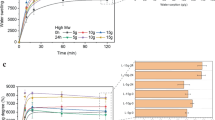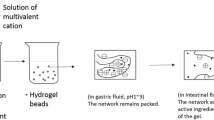Abstract
Novel bio-aerogels produced via the gelation of protein extracts from canola seed meal (CSM) are described for the first time, representing a new class of advanced materials that are derived from plant-based biotechnology. The bio-aerogels were synthesised by firstly manipulating the pH of the protein solution to form a gel, followed by freeze drying to form an aerogel with an average pore size and density of 75 µm and 0.13 g cm−3, respectively. The resulting protein-based structures were observed to have pores sizes down to the meso-scale. The mechanical behaviour of CSM-derived protein aerogels was investigated using static compressive testing. The average compressive elastic moduli and strength of the aerogels were 0.97 ± 0.32 MPa and 0.055 ± 0.011 MPa, respectively. The CSM-derived protein aerogels had compressive mechanical properties up to 196% of soy protein composite aerogels. The mechanical properties could also be manipulated by altering the pH and temperature during gelation. Gels held at ambient temperature during processing were revealed to have the highest elastic moduli (2.0 ± 0.6 MPa) and compressive strength (0.096 ± 0.014 MPa) at a pH of 8. In contrast, gels that were heated at 90 °C demonstrated the highest compressive modulus and strength at a pH of 10 (133% and 140%, respectively, as compared to the gel at pH 8 prepared at ambient temperature). The tunability of the mechanical properties using simple aqueous chemistry suggests this novel system of bio-aerogels has potential uses in a range of food and biopharmaceutical applications.










Similar content being viewed by others
References
Akimov YK (2003) Fields of application of aerogels (review). Instrum Exp Tech 46(3):287–299
Hüsing N, Schubert U (1998) Aerogels—airy materials: chemistry, structure, and properties. Angew Chem Int Edition 37(1–2):22–45
Dorcheh AS, Abbasi M (2008) Silica aerogel; synthesis, properties and characterization. J Mater Process Technol 199(1):10–26
Leventis N, Lu H (2011) Polymer-crosslinked aerogels. In: Aegerter MA, Leventis N, Koebel MM (eds) Aerogels handbook. Springer, New York, pp 251–285
Pierre AC (2011) History of Aerogels. In: Aegerter MA, Leventis N, Koebel MM (eds) Aerogels handbook. Springer, New York, pp 3–18
Pierre AC, Pajonk GM (2002) Chemistry of aerogels and their applications. Chem Rev 102(11):4243–4266
Zhao S, Malfait WJ, Guerrero-Alburquerque N, Koebel MM, Nyström G (2018) Biopolymer aerogels and foams: chemistry, properties, and applications. Angew Chem Int Edition 57(26):7580–7608
Stergar J, Maver U (2016) Review of aerogel-based materials in biomedical applications. J Sol-Gel Sci Technol 77(3):738–752
Ulker Z, Erkey C (2014) An emerging platform for drug delivery: aerogel based systems. J Control Release 177:51–63
Kleemann C, Selmer I, Smirnova I, Kulozik U (2018) Tailor made protein based aerogel particles from egg white protein, whey protein isolate and sodium caseinate: influence of the preceding hydrogel characteristics. Food Hydrocolloids 83:365–374
Yang W-J, Yuen ACY, Li A, Lin B, Chen TBY, Yang W, Lu H-D, Yeoh GH (2019) Recent progress in bio-based aerogel absorbents for oil/water separation. Cellulose 26(11):6449–6476
Fitzpatrick SE, Staiger MP, Deb-Choudhury S, Ranford S (2018) Chapter 6 protein-based aerogels: processing and morphology. In: Biobased aerogels: polysaccharide and protein-based materials. The Royal Society of Chemistry, pp 67–102
Shi W, Dumont M-J (2014) Review: bio-based films from zein, keratin, pea, and rapeseed protein feedstocks. J Mater Sci 49(5):1915–1930. https://doi.org/10.1007/s10853-013-7933-1
Ricci A, Bernardi L, Gioia C, Vierucci S, Robitzer M, Quignard F (2010) Chitosan aerogel: a recyclable, heterogeneous organocatalyst for the asymmetric direct aldol reaction in water. Chem Commun 46(34):6288–6290
Li YK, Chou MJ, Wu TY, Jinn TR, Chen-Yang YW (2008) A novel method for preparing a protein-encapsulated bioaerogel: using a red fluorescent protein as a model. Acta Biomater 4(3):725–732
Nyström G, Fernández-Ronco MP, Bolisetty S, Mazzotti M, Mezzenga R (2016) Amyloid Templated Gold Aerogels. Adv Mater 28(3):472–478
Mallepally RR, Marin MA, Surampudi V, Subia B, Rao RR, Kundu SC, McHugh MA (2015) Silk fibroin aerogels: potential scaffolds for tissue engineering applications. Biomed Mater 10(3):035002
Doi E (1993) Gels and gelling of globular proteins. Trends Food Sci Technol 4(1):1–5
Selmer I, Kleemann C, Kulozik U, Heinrich S, Smirnova I (2015) Development of egg white protein aerogels as new matrix material for microencapsulation in food. J Supercrit Fluids 106:42–49
Betz M, García-González CA, Subrahmanyam RP, Smirnova I, Kulozik U (2012) Preparation of novel whey protein-based aerogels as drug carriers for life science applications. J Supercrit Fluids 72:111–119
Baldino L, Cardea S, Reverchon E (2016) Loaded silk fibroin aerogel production by supercritical gel drying process for nanomedicine applications. Chem Eng Trans 49:343–348
Lu T, Li Q, Chen W, Yu H (2014) Composite aerogels based on dialdehyde nanocellulose and collagen for potential applications as wound dressing and tissue engineering scaffold. Compos Sci Technol 94:132–138
Jiang J, Zhang Q, Zhan X, Chen F (2019) A multifunctional gelatin-based aerogel with superior pollutants adsorption, oil/water separation and photocatalytic properties. Chem Eng J 358:1539–1551
Amaral-Labat G, Grishechko L, Szczurek A, Fierro V, Pizzi A, Kuznetsov B, Celzard A (2012) Highly mesoporous organic aerogels derived from soy and tannin. Green Chem 14(11):3099–3106
Aider M, Barbana C (2011) Canola proteins: composition, extraction, functional properties, bioactivity, applications as a food ingredient and allergenicity—a practical and critical review. Trends Food Sci Technol 22(1):21–39
Léger LW, Arntfield SD (1993) Thermal gelation of the 12S canola globulin. J Am Oil Chem Soc 70(9):853–861
Wanasundara JP, McIntosh TC, Perera SP, Withana-Gamage TS, Mitra P (2016) Canola/rapeseed protein-functionality and nutrition. OCL 23(4):D407
Totosaus A, Montejano JG, Salazar JA, Guerrero I (2002) A review of physical and chemical protein-gel induction. Int J Food Sci Technol 37(6):589–601
Kim JH, Varankovich NV, Stone AK, Nickerson MT (2016) Nature of protein-protein interactions during the gelation of canola protein isolate networks. Food Res Int 89:408–414
Klockeman DM, Toledo R, Sims KA (1997) Isolation and characterization of defatted canola meal protein. J Agric Food Chem 45(10):3867–3870
Ahmadi M, Madadlou A, Sabouri AA (2015) Isolation of micro- and nano-crystalline cellulose particles and fabrication of crystalline particles-loaded whey protein cold-set gel. Food Chem 174:97–103
Schindelin J, Arganda-Carreras I, Frise E, Kaynig V, Longair M, Pietzsch T, Preibisch S, Rueden C, Saalfeld S, Schmid B, Tinevez J-Y, White DJ, Hartenstein V, Eliceiri K, Tomancak P, Cardona A (2012) Fiji: an open-source platform for biological-image analysis. Nat Methods 9(7):676–682
Tan SH, Mailer RJ, Blanchard CL, Agboola SO (2011) Canola proteins for human consumption: extraction, profile, and functional properties. J Food Sci 76(1):R16–R28
Aegerter MA, Leventis N, Koebel MM (2011) Aerogels handbook. Springer, Berlin
Zhang X, Liu M, Wang H, Yan N, Cai Z, Yu Y (2019) Ultralight, hydrophobic, anisotropic bamboo-derived cellulose nanofibrils aerogels with excellent shape recovery via freeze-casting. Carbohydr Polym 208:232–240
Alting AC, Hamer RJ, De Kruif CG, Visschers RW (2003) Cold-set globular protein gels: interactions, structure and rheology as a function of protein concentration. J Agric Food Chem 51(10):3150–3156
Kim JHJ, Varankovich NV, Nickerson MT (2016) The effect of pH on the gelling behaviour of canola and soy protein isolates. Food Res Int 81:31–38
Lu H, Luo H, Leventis N (2011) Mechanical characterization of aerogels. In: Aegerter MA, Leventis N, Koebel MM (eds) Aerogels Handbook. Springer, New York, pp 499–535
Si Y, Yu J, Tang X, Ge J, Ding B (2014) Ultralight nanofibre-assembled cellular aerogels with superelasticity and multifunctionality. Nat Commun 5(1):5802
Chen HB, Wang YZ, Schiraldi DA (2013) Foam-like materials based on whey protein isolate. Eur Polym J 49(10):3387–3391
Kim U-J, Park J, Li C, Jin H-J, Valluzzi R, Kaplan DL (2004) Structure and properties of silk hydrogels. Biomacromol 5(3):786–792
Finlay K, Gawryla MD, Schiraldi DA (2008) Biologically based fiber-reinforced/clay aerogel composites. Ind Eng Chem Res 47(3):615–619
Acknowledgements
The authors would like to thank Biopolymer Network Limited (New Zealand) for supporting this research programme and associated doctoral stipend. Additionally, this research was also made possible through technical support from staff in the Proteins and Biomaterials team at AgResearch Limited (New Zealand).
Author information
Authors and Affiliations
Corresponding author
Ethics declarations
Conflicts of interest
The authors declare that there are no conflicts of interest.
Additional information
Publisher's Note
Springer Nature remains neutral with regard to jurisdictional claims in published maps and institutional affiliations.
Electronic supplementary material
Below is the link to the electronic supplementary material.
Rights and permissions
About this article
Cite this article
Fitzpatrick, S.E., Deb-Choudhury, S., Ranford, S. et al. Novel protein-based bio-aerogels derived from canola seed meal. J Mater Sci 55, 4848–4863 (2020). https://doi.org/10.1007/s10853-019-04330-w
Received:
Accepted:
Published:
Issue Date:
DOI: https://doi.org/10.1007/s10853-019-04330-w




